If you’re headed to Bhutan, visiting the legendary Paro Taktsang—better known as the Tigers Nest Monastery—is an absolute must! Plunging dramatically to the edge of a cliff, this monastery isn’t just a sight to behold; it’s a place of profound spiritual importance for the Bhutanese people. According to local legend, Guru Rinpoche, the revered saint who introduced Vajrayana Buddhism to Bhutan, flew to this very spot on the back of a tigress, which is how it earned the enchanting name, “Tiger’s Nest.”
The monastery stands as a symbol of Bhutan’s deep-rooted connection to Vajrayana Buddhism, a mystical branch of the religion that emphasizes meditation and ritual to reach enlightenment. For many pilgrims, this is a sacred space for reflection, prayer, and devotion. And for travelers, it offers not just stunning views but a glimpse into the heart of Bhutanese spirituality.
So, for a traveler, it offers both an exhilarating adventure and a peaceful retreat, the Tigers Nest Monastery is sure to leave you mesmerized. And to make sure your visit is as smooth and rewarding as possible, we’ve put together the ultimate Tigers Nest Monastery guide to help you plan every detail—from the best time to visit to what to pack, and how to prepare for the Tiger Nest hike. This guide will ensure that you’re fully equipped to make the most of your journey to one of Bhutan’s most iconic landmarks!
Best Time to Visit Tigers Nest
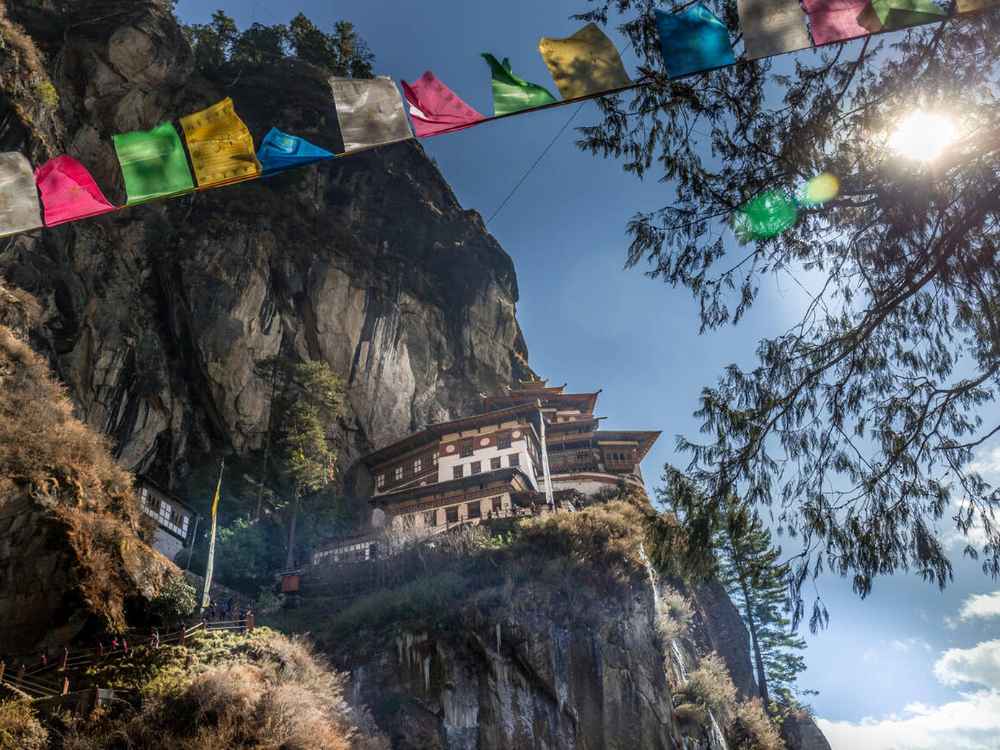
- Seasons & Weather
The ideal time to visit Paro Taktsang is during the spring (March to May) and fall (September to November). These months offer clear skies, making the views of the monastery and surrounding mountains absolutely breathtaking. The weather during these seasons is mild and pleasant, perfect for trekking. In spring, the blooming rhododendrons add vibrant colors to the landscape, while in autumn, the crisp air and golden leaves create a serene atmosphere. - Festivals
Visiting during the Paro Tsechu, a Buddhist festival usually held in March or April, enhances the experience of visiting Paro Taktsang. The festival celebrates Guru Rinpoche with traditional mask dances, religious performances, and rituals, attracting both locals and tourists.
Recommended Read: Discovering the Best Time to Visit Bhutan
How to Reach Tigers Nest?
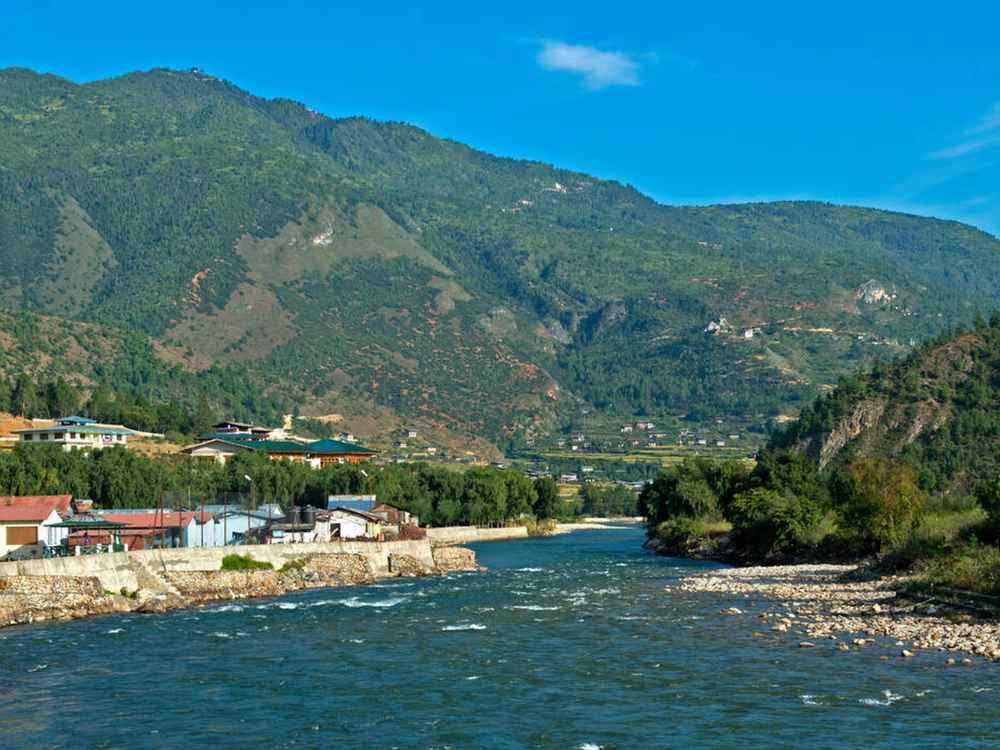
Paro Taktsang is located in the western part of Bhutan and lies in the Paro Valley (7200 ft.) which is known to be one of the most fertile and picturesque valleys in the country. The valley is formed by the Paro Chhu (river), which flows through the town and the surrounding countryside. Travelers can get a quintessential Bhutanese countryside experience here due to its rugged hills, lush green fields, traditional farmhouses, and stunning views of the Himalayan foothills.
The trek to the monastery takes you through pine forests and up steep, zigzagging paths that provide breathtaking views of the surrounding landscape.
- Fly into Paro International Airport: This is the only international airport in Bhutan, making it the primary entry point for travelers. The airport is approximately 15 kilometers and takes around 30-40 minutes from the Tiger’s Nest trailhead.
- Travel from Paro Town to the Base:
- By Taxi: Visitors can hire a taxi from Paro town to the parking area at the base of the monastery. This ride typically takes about 20-30 minutes.
- Guided Tours: Many travelers join organized tours that include transportation to the base of Tigers Nest Monastery.
Read More: 10 Reasons Why You Should on a Road Trip to Bhutan
Tigers Nest Monastery Hike
The only way to reach the monastery is by hiking, as there are no vehicles allowed on the trail.
Trail Overview:
- Distance: The Tiger Nest Monastery trek distance is approximately 6.4 kilometers round trip.
- Elevation Gain: Ascent is about 1,700 feet, while the Tiger Nest height is 10,232 feet.
- Hiking Time: Most hikers take between 6-7 hours for a round trip to Tiger’s Nest, depending on their fitness level and pace.
The Starting Point
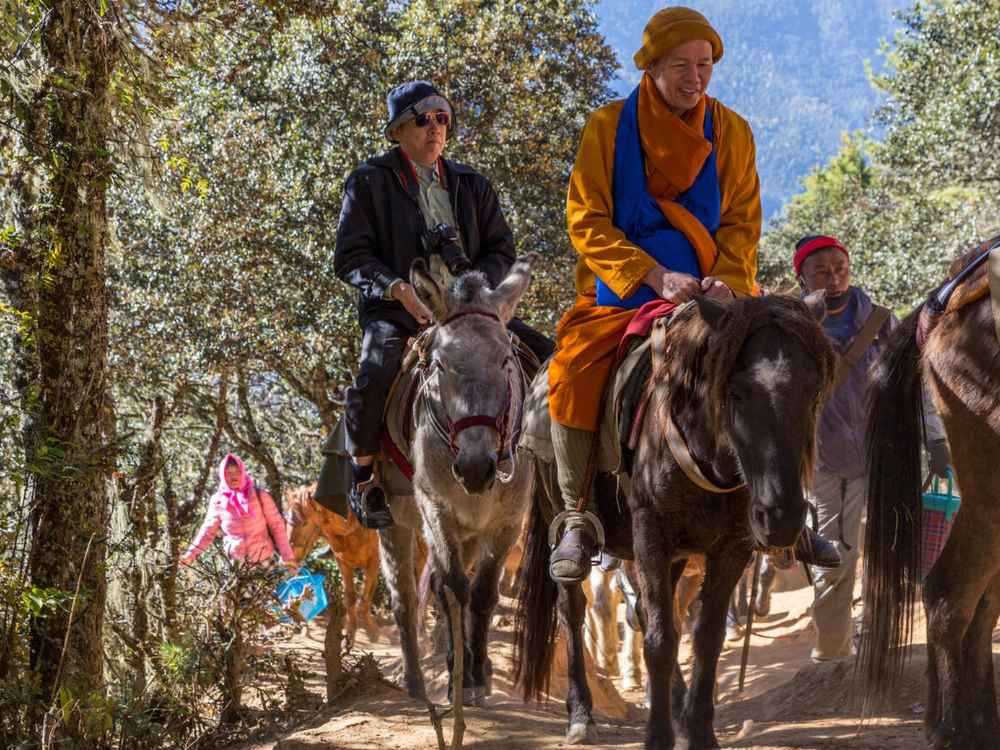
Travelers start the trek from the parking lot of Paro Taktsang and it begins at 8 AM. However, it is better for you to start the trek when it opens in order to return in time.
A few vendors sell souvenirs and rent trekking poles (usually ranging from INR 50-100). This area marks the start of your trek through beautiful pine forests and rhododendron bushes. You can also buy tickets to enter the monastery from the counter here. Usually, the Tiger Nest entry fee is INR 2000 for adults and INR 1000 for children, but you only have to buy them if you wish to visit the monastery and not for the hike to the Tigers Nest viewpoint. You can hire ponies from the base, they cost around INR 1200 one-way, and they drop you at the Taktsang Cafeteria, which is the midway point of the whole hike.
The Midway to Tiger’s Nest
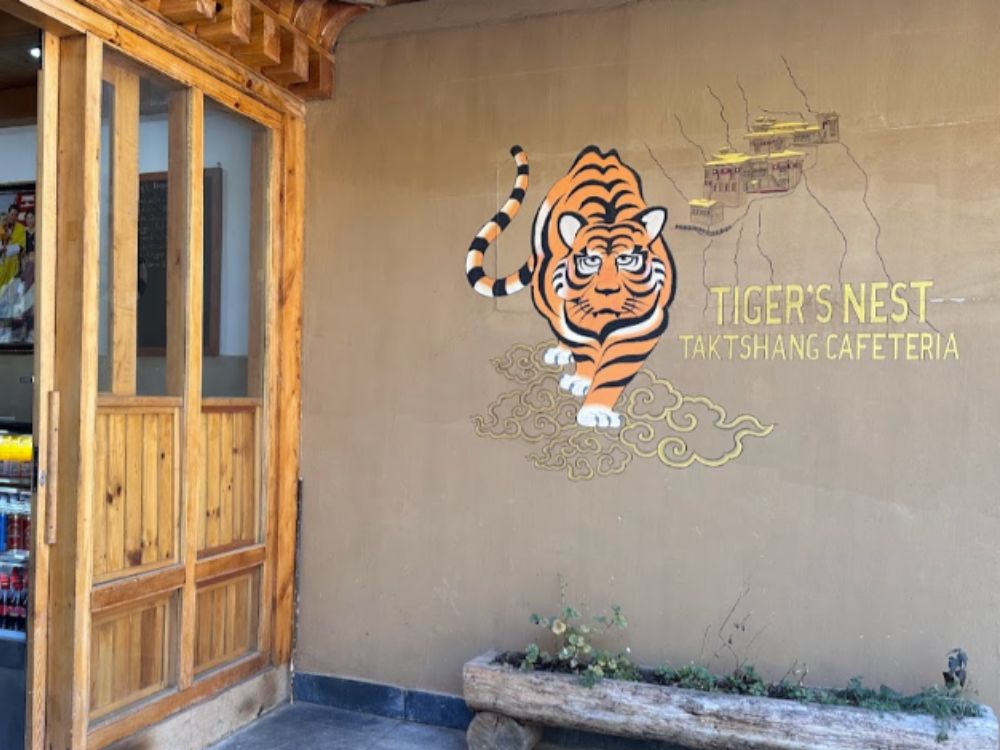
About halfway up, there is the Taktsang Cafeteria where hikers can rest and refuel themselves, you can use the washroom, fill up water bottles, have some hot drinks or a filling lunch. This cafe also offers the first clear and a great view of Paro Taktsang, it is also a good place to take photos before continuing the ascent. Many return from this point or hike all the way to the Tigers Nest Monastery.
Pit Stop: As you trek toward Paro Taktsang, The Pema Sangye Sandrup Chhoekhorling Temple is a peaceful stop along the way, adorned with prayer flags. The temple is a significant structure often overlooked by visitors focused on reaching the main monastery, this small temple carries its own spiritual importance and adds to the sacred atmosphere of the trek.
The Tiger’s Nest View Point
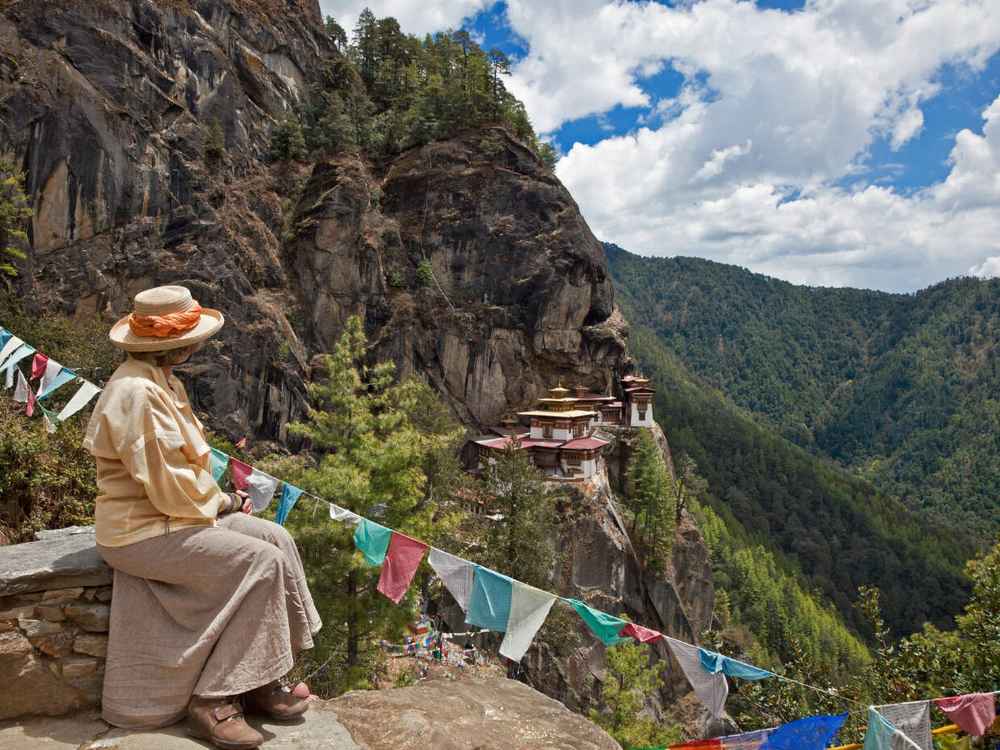
The journey from Taktsang Cafeteria to the Tigers Nest Monastery viewpoint is one of the most exciting and scenic parts of the trek to Paro Taktsang. After a brief rest at the cafeteria, trekkers begin the final and slightly more challenging portion of the hike. The distance is about 1.5 kilometers (around 30 to 45 minutes), but the terrain becomes more rugged compared to the earlier part of the trek. The air becomes thinner and breathing becomes a little difficult on this patch. The trail is steeper, with narrow, winding paths leading through pine forests, accompanied by the fluttering of prayer flags tied to branches, which add a sense of calmness.
As you continue uphill, the views of Paro Taktsang gradually become clearer. The Viewpoint rewards you with the closest and most iconic perspective of Paro Taktsang. You can see the full grandeur of the Tigers Nest Monastery clinging to the steep cliff, surrounded by clouds and mist. This spot offers incredible photo opportunities while some just sit here and absorb the energy of the place. For Bhutanese pilgrims, this is a highly spiritual moment where they feel close to the blessings of Guru Rinpoche. Many head downward from here as well, but if you have bought the ticket, it only makes sense for you to reach and take a tour of the monastery as well.
Pit Stop: Next, halt by a small cave located along the path to Paro Taktsang. It is the cave where Je Khenpo took birth and his connection to Paro Taktsang is quite significant, personally and spiritually. After returning to Bhutan from extensive studies in Tibet, he undertook a three-year meditation retreat at the Taktsang Palphug hermitage, located within the Taktsang complex.
The Final Stretch
The path eventually leads to a stone staircase that descends into a gorge, crossing a small bridge over a beautiful waterfall. This is where the monastery comes into full view, creating an awe-inspiring moment as you stand directly across from it. The sound of the waterfall adds to the serene atmosphere, making this a place where many trekkers stop to take photos or rest before climbing the final flight of steps.
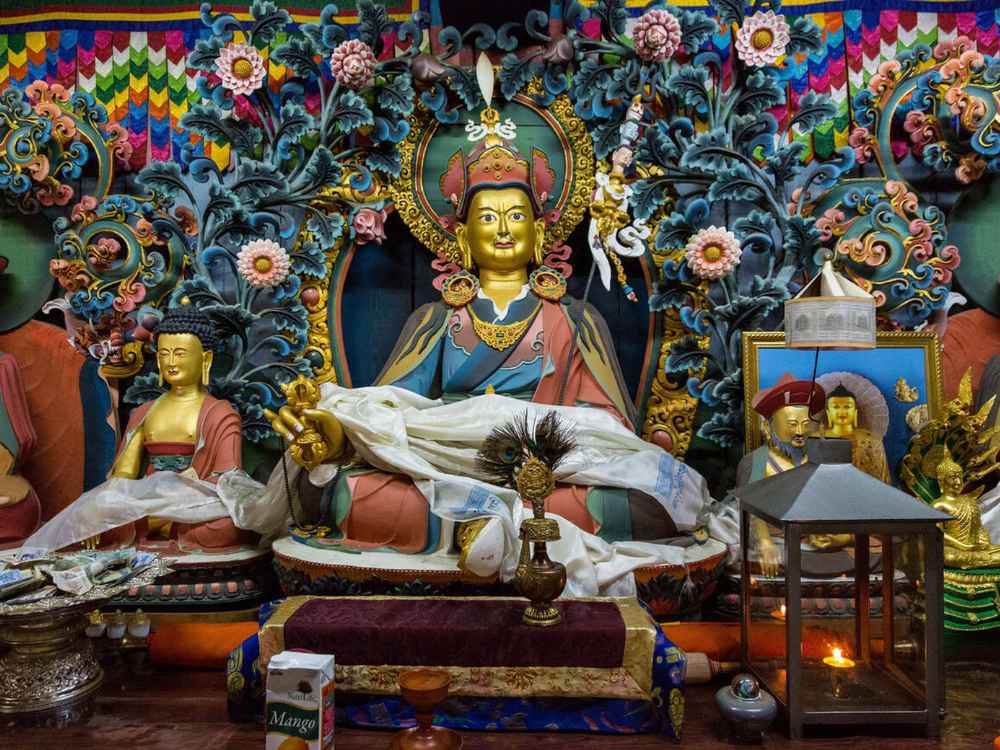
The monastery is a complex of buildings connected by stairways and bridges. It has a total of four main temples and various smaller shrines. You’ll get a tour of the monastery, conducted by a monk. The central hall holds a statue of Guru Rinpoche (Padmasambhava) in his most fierce form, surrounded by protective deities.
One of the most important and sacred places inside is the cave where Guru Rinpoche meditated in the 8th century. It is believed that he flew to this spot on the back of a tigress, hence the name “Tiger’s Nest.” Inside the monastery, visitors can offer butter lamps; the act of offering these lamps holds deep spiritual significance in Bhutanese Buddhism. The monastery’s quiet, filled with the scent of incense, the soft flicker of butter lamps, the chanting of monks making the experience special.
Photography is generally not allowed inside, preserving the sanctity of the space, and visitors are expected to maintain a respectful silence to honor the monks and practitioners engaged in prayer.
Preparing for the Trek
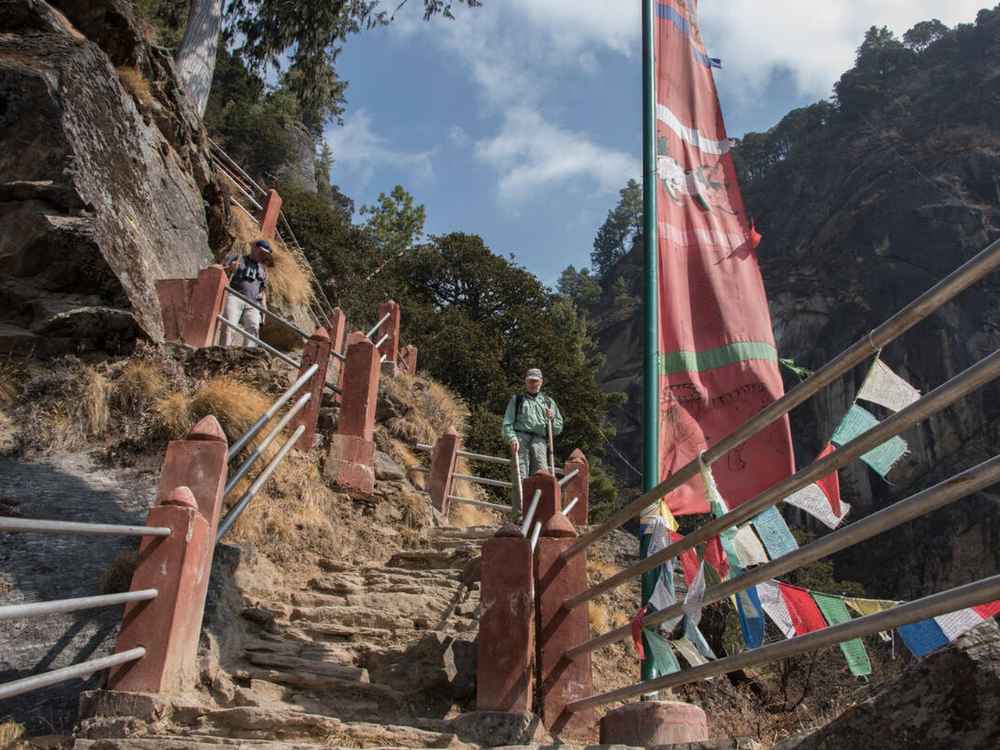
- Start early in the morning and reach the base by 8 AM to avoid crowds and heat later in the day.
- Dress modest and in layers to accommodate changing temperatures throughout the trek.
- Carry essentials only; a sunscreen, water, light snacks for energy during the hike.
- The trek is moderately difficult, it is important to keep hydrating, pacing yourself, and not rushing.
- Wear trekking shoes that support ankles and rent a walking stick (if needed).
- Consider hiring a horse if you think hiking all the way up might be difficult on foot; ponies can carry you partway up.
Read More: Bhutan Visa for Indians & Entry Permit for a Hassle-Free Entry
Make sure you are respectful of the local customs, environment, and spiritual nature of the place. Do not litter and carry all your waste back with you.
Tiger’s Nest Monastery FAQs
How difficult is Tigers Nest trek?
The Tiger’s Nest trek is considered moderately difficult, primarily due to its steep ascent. While fit individuals may find it manageable, those with mobility issues or respiratory problems should reconsider tackling the Tiger Nest hike.
What is the significance of the Tigers Nest monastery?
The Tiger’s Nest Monastery, or Paro Taktsang, is significant as a sacred Buddhist site, believed to be where Guru Padmasambhava meditated in the 8th century. It symbolizes Bhutanese spirituality and resilience .
How much does it cost to go to Tiger’s Nest monastery?
The cost to visit the Tiger’s Nest Monastery typically includes a tour package, as independent travel is not allowed in Bhutan. The tiger nest entry fee is generally included in these packages, which can range from $200 to $250 per day for foreign tourists.
How long is the hike to Tiger’s Nest?
The hike to Tiger’s Nest covers a distance of approximately 6 kilometers (4 miles) round trip, with an elevation gain of about 1700 feet. Most hikers complete it in 4-7 hours, depending on their fitness level.
Who lives at Tiger’s Nest?
The Tigers Nest Monastery is primarily inhabited by monks who conduct religious practices and rituals. It remains an active monastery, attracting both pilgrims and tourists.
How many stairs are there in Tiger’s Nest?
There are around 700 steps leading to the monastery, with various steep sections that can be challenging for some hikers.
Can you stay at Tiger’s Nest?
Overnight stays at the Tiger’s Nest are not permitted; however, visitors can explore the monastery during daytime hours.
What is the specialty of the temple Tiger’s Nest monastery?
The specialty of the Tigers Nest Monastery lies in its breathtaking location on a cliffside and its rich history as a pilgrimage site. It offers stunning views of the Paro valley and showcases exquisite Bhutanese architecture and artwork.
Travel Beyond: Bhutan Road Trip With JustWravel






